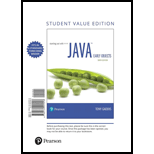
Concept explainers
The isDigit, isLetter, and isLetterOrDigit methods are members of this class.
- a. String
- b. Char
- c. Character
- d. StringBuilder
Methods of the class:
The methods “isDigit”, “isLetter”and “isLetterOrDigit” are some of the members of the class “Character”.
Hence, the correct answer is option “C”.
Explanation of Solution
Character class:
- A wrapper class that is used for the char data type is called as “Character” class.
- It contains various method for testing and converting the data that is of character type.
- The character is a part of “java.lang” package and it does not needed to be imported for using the class.
- It contains various static methods for testing the value of the character variables.
Reason for the incorrect answers:
String:
The class is used to represent character of strings.
Hence, the option “A” is wrong.
Char:
“char” is considered as the data type but not the class.
Hence, the option “B” is wrong.
StringBuilder:
The class is used to create a changeable strings and it is similar to String objects.
Hence, the option “D” is wrong.
Want to see more full solutions like this?
Chapter 8 Solutions
Starting Out with Java: Early Objects, Student Value Edition (6th Edition)
Additional Engineering Textbook Solutions
Modern Database Management
SURVEY OF OPERATING SYSTEMS
Starting Out with Programming Logic and Design (5th Edition) (What's New in Computer Science)
Java: An Introduction to Problem Solving and Programming (8th Edition)
HEAT+MASS TRANSFER:FUND.+APPL.
Thinking Like an Engineer: An Active Learning Approach (4th Edition)
- Please solve and answer the questions correctly please. Thank you!!arrow_forwardConsidering the TM example of binary sum ( see attached)do the step-by-step of execution for the binary numbers 1101 and 11. Feel free to use the Formal Language Editor Tool to execute it; Write it down the current state of the tape (including the head position) and indicate the current state of the TM at each step.arrow_forwardI need help on inculding additonal code where I can can do the opposite code of MatLab, where the function of t that I enter becomes the result of F(t), in other words, turning the time-domain f(t) into the frequency-domain function F(s):arrow_forward
 EBK JAVA PROGRAMMINGComputer ScienceISBN:9781337671385Author:FARRELLPublisher:CENGAGE LEARNING - CONSIGNMENT
EBK JAVA PROGRAMMINGComputer ScienceISBN:9781337671385Author:FARRELLPublisher:CENGAGE LEARNING - CONSIGNMENT Microsoft Visual C#Computer ScienceISBN:9781337102100Author:Joyce, Farrell.Publisher:Cengage Learning,
Microsoft Visual C#Computer ScienceISBN:9781337102100Author:Joyce, Farrell.Publisher:Cengage Learning, C++ Programming: From Problem Analysis to Program...Computer ScienceISBN:9781337102087Author:D. S. MalikPublisher:Cengage Learning
C++ Programming: From Problem Analysis to Program...Computer ScienceISBN:9781337102087Author:D. S. MalikPublisher:Cengage Learning EBK JAVA PROGRAMMINGComputer ScienceISBN:9781305480537Author:FARRELLPublisher:CENGAGE LEARNING - CONSIGNMENT
EBK JAVA PROGRAMMINGComputer ScienceISBN:9781305480537Author:FARRELLPublisher:CENGAGE LEARNING - CONSIGNMENT C++ for Engineers and ScientistsComputer ScienceISBN:9781133187844Author:Bronson, Gary J.Publisher:Course Technology PtrProgramming Logic & Design ComprehensiveComputer ScienceISBN:9781337669405Author:FARRELLPublisher:Cengage
C++ for Engineers and ScientistsComputer ScienceISBN:9781133187844Author:Bronson, Gary J.Publisher:Course Technology PtrProgramming Logic & Design ComprehensiveComputer ScienceISBN:9781337669405Author:FARRELLPublisher:Cengage





